I don’t know if I can extrapolate this idea properly. But I am going to try.
Often here and other places I bring up our video game Procyon Frequency. It’s not a shill - there is nothing to shill yet. We don’t even have a demo out. The reason I bring it up or even use it as a springboard for other creative ideas is because it is my magnum opus of weird.
I think the worst thing you can do to a man is insist he read Tolkien before he runs a D&D game. Tolkien is indisputably a part of the Appendix N milieu of works drawn upon for the creation of D&D, but it’s almost drastically so removed that being a Tolkien nerd first becomes a burdensome error to anyone trying to create their own fantasy setting. Because the work is so vast, so intrinsically tied into myth, and so fleshed out and structured to resemble a real developed place, Hobbit-Heads are going to have a tough time removing themselves and their game from the many established tropes poked at in innumerable copycats which came after. And the problem is - especially for people who aren’t a professor who create their own languages and then base a story off of those languages - YOU are never going to be able to do so in an adequate or convincing way. Even George R.R. Martin just took a slice of history and essentially hamstrung dragons into it. Sorry Game of Thrones fans, but there is nothing I can think of that is really original or exciting about the fantasy aspect of his books that wasn’t already done ten thousand times better decades before he was born.
Now I am admittedly not a scholar of Appendix N. Because I too made this mistake. I have devoured anything Tolkien since I was a kid. I have read every piece of Lovecraft available to me. And I have read a significant amount of Robert E. Howard’s work, and certainly all of his most critically acclaimed work. So when I first poked through Appendix N and saw those listed as critical reading material, I figured foolishly that my familiarity with those particular works was enough to perhaps absolve or make up for all the stuff I wasn’t familiar with.
It took fifteen minutes of reading Jack Vance for me to hang my head in shame and realized how badly I had screwed everything up.
I am lucky in that I’ve never shied away from or been “embarrased” by more simply fairy stories and fantasy. Procyon Frequency itself if anything was a reaction to serious science fiction and its propensity to dumb everything down to a universe where everything had to be justified based on current theoretical scientific knowledge. The odd time when I find out that I have inadvertantly come up with an idea that is close to the game Mass Effect, I have instructed my business partner to immediately inform me so that I can correct it. And it’s not because I think Mass Effect is a bad game - I don’t think much of it at all because I played about five minutes of it before uninstalling it. It’s because Mass Effect and Procyon Frequency share the same source of influence, the Star Control series, and in seeing alien designs for Mass Effect when the game was originally hyped up and reviewed, I couldn’t help but feel a tragic sense of depression about how woefully dull it was compared to the quirky, often humorous pulp sci-fi aliens of that timeless series they were paying homage too.
Okay, I am being somewhat unfair here. There are some standouts. Weird squiddies and bug creatures, sure, good. But these seem to be an exception to the more standard Star Trek design of “guy in thick makeup”. And when they aren’t, when they are bugs or cows or whatever, they are usually a pretty sparse color palette and are primarily intimidating looking. Mass Effect was going for epic dramatic space opera, and Star Control was going for…this.
And this.
And this.
And this.
These guys by the way are called the Orz, and if you have beaten Star Control 2 aka The Ur-Quan Masters, you will understand them to be the creepiest thing in that entire game even though they talk in a calm androgynous voice and like to *play*.
But how do you take designs like this and make a story that has serious moments of gravity in it when you have ships that make a fart noise when they shoot rockets out their back end, or a race of aliens who recharge their gun batteries by calling their oponent a litany of vile M rated insults like “stupid” “idiot” “baby” and “worm?”
Ask Paul Reiche III and Fred Ford. They figured it out. They made a world and narrative in the sci-fi genre of video games that is unmatched to this day in its creativity. One about genetic manipulation, genocide, xenophobia, and a race of aliens so cowardly that they willingly enslaved their own homeworld under an imprenetrable shield.
This is where me gushing about Star Control ends and where me name dropping a conversation I had with one of them begins.
When we started our company Mycelium Games back in the spring, I originally wanted to call it Juffo-Wup Games. This is a reference to Star Control 2 I am not going to talk about because I want you to go and play the game NOW. Back then, we were doing nothing remotely Star Control adjacent. We had designed and prototyped a Cyberpunk wargame of area control called Legends of Lotus City. It was really neat. It was really fun. And it would have been way, way too expensive to produce, so we didn’t - another time perhaps.
It looked like this and…
Well forget it, it’s not important.
A few years prior myself and my co-director at Mycelium had worked on another project together which was essentially a Diablo 2 clone, but we weren’t as dedicated to the craft at that point, and frankly although we were friends, our relationship hadn’t built to the heights it sits at today, where the other night we had a two hour conversation about finding an obscure early 2000’s author nobody knew about that we both like before inevitably stalking his online presence and comparing pictures to see if we had found the right guy until I laughed so hard I pulled an intercostal muscle. Guys, this is why I push for men to have their own spaces - you will never find this kind of entertainment with a woman in the room which is why things really amped up to tenth gear when my wife finally got sick of our annoying convo and went to bed.
But at this time I still wanted to use Juffo-Wup because of a mutual interest we had in mushrooms and their mycelial networks. Mushrooms are fascinating. They are fascinating in many ways, and though I am clean these days, I have experienced some of them that you can’t just find at the grocery store. So I thought it would be a fun little in-joke and an homage to two of my favorite creators.
I found both of the creators of Star Control and messaged them, and they were both incredibly friendly, but were not keen on the idea. They had just been engaged in a year-long lawsuit with Stardock, current owners of the Star Control IP that had caused them a tremendous headache they never wanted to repeat. They did not say no, but they expressed this discomfort and so to honor their wishes, I changed the name to Mycelium - a good compromise, and still a fun name with potential for cute mushroom men in the logo.
But during this conversation D&D came up. I was told that both of them still play D&D today - B/X specifically - and that their DM is none other than Erol Otus! It makes sense, Erol Otus did artwork and other things for the Star Control series, and unlike us gross nerds in the space of arguing about dumb RPG crap, Paul and Fred are genuinely nice well to do people, so it’s not surprising they kept in contact.
They are also both extremely busy. They created the Skylanders series, and up until recently were working together on the new Star Control entry titled Free Stars: Children of Infinity, but Paul Reiche III has since gone onto retire after making his story and narrative contributions to the game which continues develop in Fred and his company Pistol Shrimp’s capabale hands.
Paul - rest easy. You owe the world nothing else.
Also apologies to BioWare. I have a friend who works for them, and I don’t know if he would like me dumping on Mass Effect. I’m sure it’s a fine game. I’ll never know because I have accidentally plagiarized it more than once and will not repeat that mistake if I can avoid it.
Anyways, it may be a purely symbolic connection I am making here, but the point is, Star Control and Mass Effect, or insert other serious sci-fi opera here have a similar juxtoposition to the sort of D&D some of us oldheads run and the modern D&D which seems to have an infatuation with the exemplification of very specific ideas while eschewing a lot of what Appendix N suggestions were trying to drive at.
In a way I think that codifying so many things so explicitly actually helped to create this problem even though it didn’t arise until much later, because you have a literal monster manual that, for new DM’s, effectively deceives them into thinking that whatever is in this book is ALL that they can put in their game. And so you get a lot of Forgotten Realms adjacent games being pumped out, never mind the constant shill of static adventure modules that is even further interrupting any opportunity for real creativity for the people buying into that episodic DLC structure WOTC wants to badly to commit too (and it is only going to get worse.) So was this Gygax’ fault in making a game that was so complete and so coherent that it pushed everyone into a lockstep adherence of its ideas?
I’m not going to continue because I don’t want to be hung up by my scrotum. But the answer is probably not. There are plenty of weird modules games and ideas to go around to prove that D&D hasn’t become this completely milquetoast Tolkien simulator that I maybe sound like I am suggesting it is. But I am saying that for a vast majority of DM’s and players adhering to the 5th edition school of thought, that this is very likely going to be the case. And that this drive for creating long expansive campaign narratives with the standard big bad dark lords, and these overly fleshed out yet increasingly mundane fantasy worlds is stifling the potential for the truly creative fantasy Appendix N espouses - and it only took me reading a single Jack Vance short story to figure this out.
The other night I watched Gandahar, a French cartoon from the late eighties re-configured and named Light Years here overseas and was reminded of its bizarre, unyielding creativity, strangeness and beauty.
I loved that film when I was a kid and discovered it only through frequent rentals on a half blurred VHS tape with warped sound at my local video store so it was a real treat to watch it in full HD fidelity and simply marvel at some of the stuff it was doing.
And it has a lot of boobs in it. Heavy Metal, eat your heart out.
But it immediately made me look at my own D&D creations over the year and question every single decision I had ever made. Nothing I had “invented” (IE stolen) even came close to making such an alien but realized setting. And what a shame! Medieval historical fantasy and a push into hard-sci fi after this era has been responsible for a lot of the dreck that infects these genres now to the point where when I do get the courage to listen to a fantasy recommendation, it is almost categorically the same kind of crap I have fought to avoid ingesting - thousands of pages of descriptions of lineages I couldn’t possibly care about where the only fundamental difference is that “well, OUR goblins have muskets, and they are funny.” And in most of it, hell, you’ll be lucky if the author isn’t pretentious enough to think that anything beyond a five foot tall humanoid is too “out there” for his work to be taken seriously.
Lovecraft’s work was in a magazine called Weird Tales. Here is the very first image of what an old Weird Tales cover looked like.
Now here is one of the first images that popped up which actually had art at all when I searched for popular fantasy books in 2024.
A wizard in a hoodie poring his magic over a PDF print on demand. Necronomicon eat your heart out!
Last week there was a bit of a contest within the brOSR where we were challenged to come up with ideas for a Braunstein. There were some pretty creative ones in there, and some not so much - Nazi’s trying to take over Atlantis was the winner and my personal favorite - and my own entry was A Night on Bald Mountain. Find the Horn of Chernobog, and when you use it, Chernobog breaks through the top of the mountain in the middle of the map and hurls lava bombs at your opponents strongholds.
Factions included dark witches, snake-centaurs, and fairies. Tolkien himself referred to his own work as a “fairy story”, and most of the races were taken from fairy tales and myth. So while not wholly original by any means, that idea was far far closer to the kind of fantasy Appendix N is interested in than just about anything else I have ever come up with. Even my current Greyhawk game is pretty standard and by all means is below my own personal standards for encouraging weirdness. But guys in the brOSR are embracing this kind of stuff all the time. So, in a way - it’s not US, it’s YOU, and you all need to do better.
(Sorry but it is my legal obligation as a brOSR to have a holier-than-thou attitude about these things, it’s etched on tablets buried somewhere in Wyoming, I don’t make the rules.)
And ultimately I’m a bit split, because I like the idea of coming up with more grounded worlds just from the perspective of creating an immersive and perhaps more relatable virtual world. But it also has the potential to become very uninspiring to the people who are engaging with it if it’s not sufficiently mixed in with the sorts of pulp fantasy and sci-fi D&D was predicated upon.
There is a good reason bros don’t seem to be afraid of basing their games on old cartoons or fairy stories, and it’s because they are FUN. They are unique, and much of the time, have no concern or consideration whatsoever for the larger scope of what is going on. We don’t need a prequel story about how the witch in Hansel and Gretel became an evil diabetic. We just know there is a witch in the forest that can’t be trusted and she gets burned alive by a couple of smart-ass brats in the end. The story concludes, and we don’t need to know how Hansel and Gretel went on to break her cabin into it’s component parts and open a successful candy shop after. Though admittedly, in a D&D game, that is almost assuredly what some money grubbing players would figure out, and they might just do that for the next five sessions until the DM decided to take up alcoholism as a replacement hobby.
I have been toying around with a world specifically inspired by the old cartoon The Mighty Hercules. It was a fairly short lived cartoon with an even shorter runtime - about five minutes per episode - that would often air with other shorter cartoons or in chunks of episodes, all about Hercules and his annoying roommate and their adventures in subduing the newest monster of the week. It also had a rockin’ theme song, and the lyrics “iron in his thighs” have never been uttered elsewhere to this day.
Hercules is…not brilliant. It’s about as simple as it gets. The animation is cheap. Most of the runtime is some developing problem usually resolved by Hercules punching a monster in the face a couple of times and calling it a day. But when I got a flu I went back to revist it I realized that it was not a bad setup for a night of D&D because it knows what it is, it doesn’t spend really any time at all developing its setting, because we intrinsically get it just by cultural association to Greek myth which most of us in the west at least spent a class learning about in elementary school. And it’s straightforward - problem happens, solve problem. It doesn’t have time to meander, and contains a cast of if not wholly original than at least very identifiable and distinguishable characters, and bizarre beasts for Hercules to punch in the balls before the runtime is through.
And to me this actually makes for a better game premise and better time for a DM because they don’t have to sit there and come up with a complete lineage of family legacy of King Garblablah of the Six Isles or whatever that no one could possibly care to spend their time on his blog reading about it. It amounts to a bunch of cruft better served for dorks on YouTube trying to leverage a liveplay into a crappy (but very pretty!) sourcebook Kickstarter than it ever would your average DM who doesn’t have time to invest their life into being an internet celebrity so that they can capitalize on a thing they do once a month for four hours.
The whole point of the Braunstein contest was that the one who spearheaded it, Bdubs, was trying to demonstrate than you can come up with a playable setting in the space of a single X post. But whether intentional or not, he also proved that the best way to do this is by going outside the box of mundane high fantasy and tapping into the weird. And one of the weirdest entries came out on top for that very reason - because “Five kings battling over a kingdom” is barely an idea let alone an interesting one compared to “The Spider Gang has to fight the She-Eeels for ownership of the Rose Harp, which can play a note that turns entire armies blind”. That wasn’t one of the entries, I came up with it just now, and it’s already a better idea than most adventure modules.
“But Joel, that idea is stupid and sucks.”
Yeah, my point exactly.
There are just too many people tapping into dreck when they should be letting loose and diving into pulp, legend, myth, and fairy-tales, because these things will undoubtedly prove to be an instantly more interesting and relatable experience to the average person than just catering to the die-hard medievalist or Tolkien reader. To people like my friend Amanda, who has two kids and a job and who doesn’t have all day to spend on this crap, it’s just instantly more resonant in getting them to understand what they are doing without feeling like they need to watch a documentary on A&E about the War of the Roses first to really feel an attachment to it. We grew up all our lives hearing about a pea that could be felt through ten mattresses, and a girl in a tower letting a mile of hair drop to the ground for her prince charming to climb up and cathartically murder his mother in law to save her, and that familiarity doesn’t wane over time. It’s the same reason why moms are flocking in droves to see Wicked despite the fact that they haven’t seen The Wizard of Oz since they were toddlers. This is true fantasy, in all its timelessness. And for a game that is all about fantasy, the people running it are not thinking fantastically enough most of the time to make it work beyond a session or two.
My son refers to this as “brainrot”. And my response to that is “skibidi sigma no cap Fortnight Feastables Lunchly KSI”.
Or something. I have no idea what kids are talking about these days - but I know that all of my kids like old Disney cartoons, the same ones I enjoyed, even though they couldn’t give a good damn about Tolkien.
So get out there and make it weird. Now if you’ll excuse me, I need to go read the entirety of Appendix N to fight off my gnawing imposter syndrome.




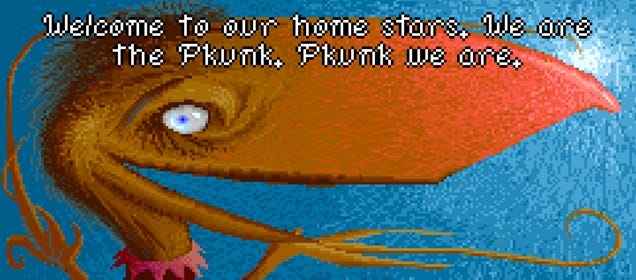

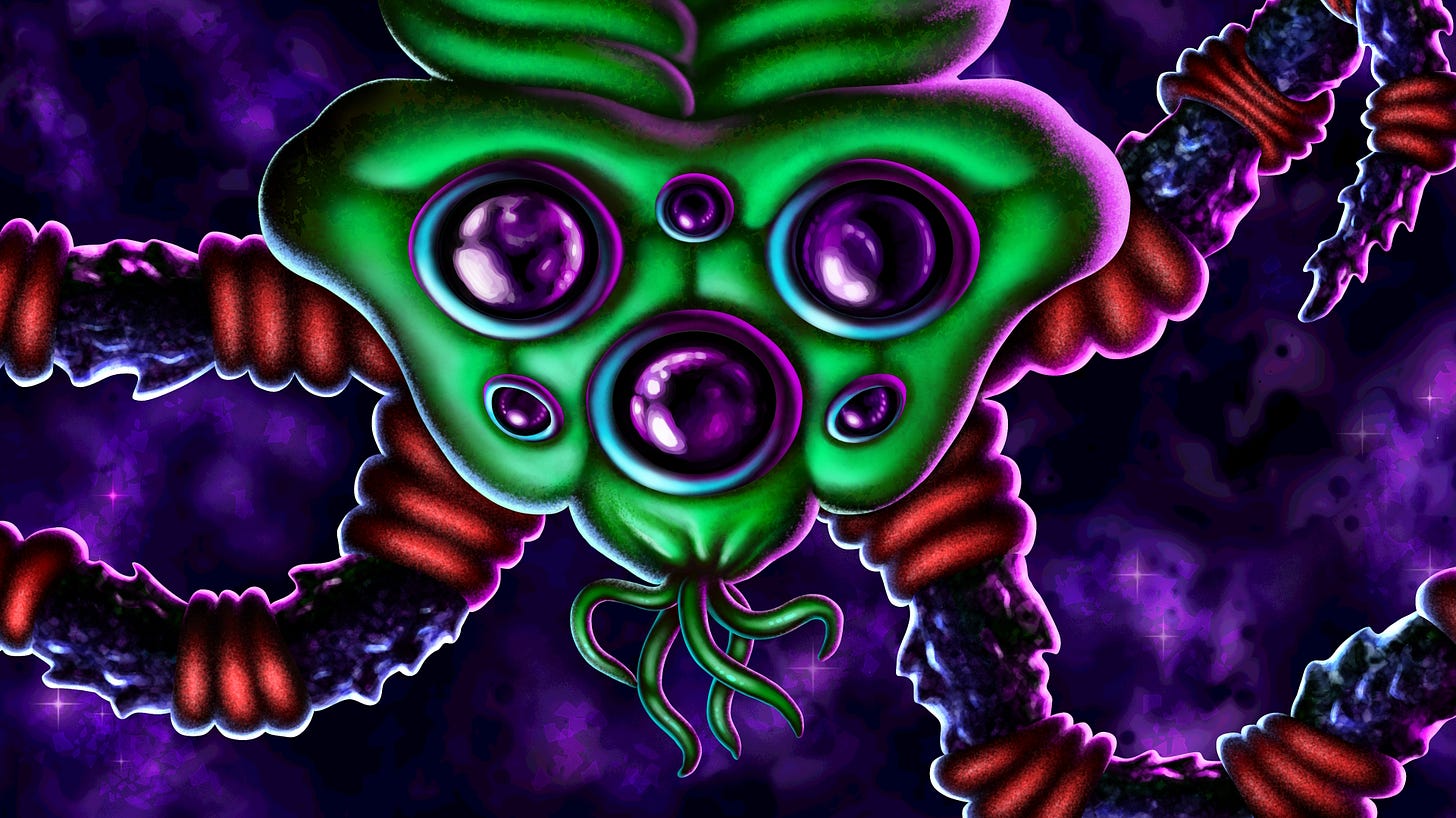
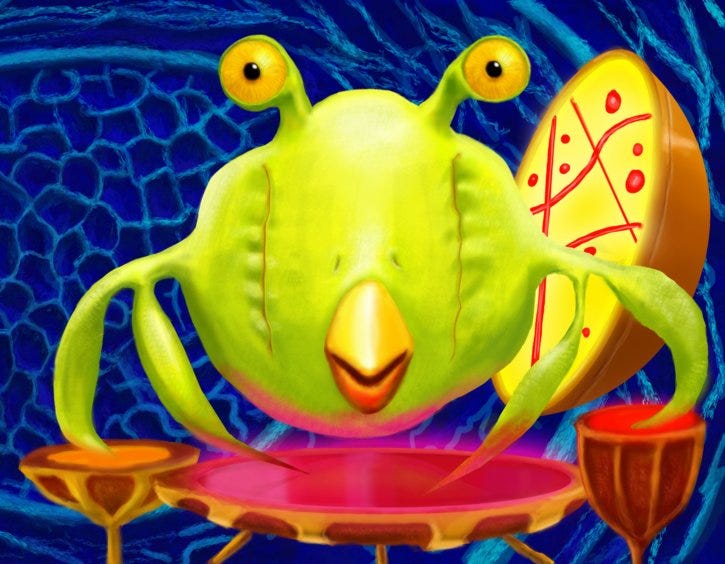



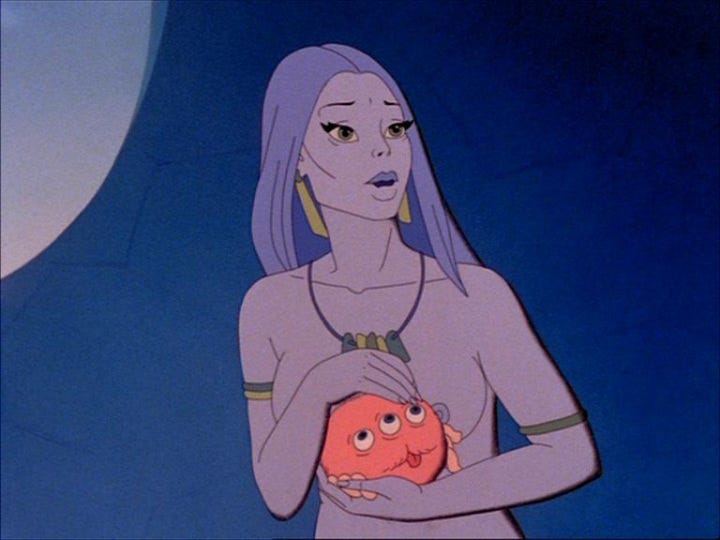
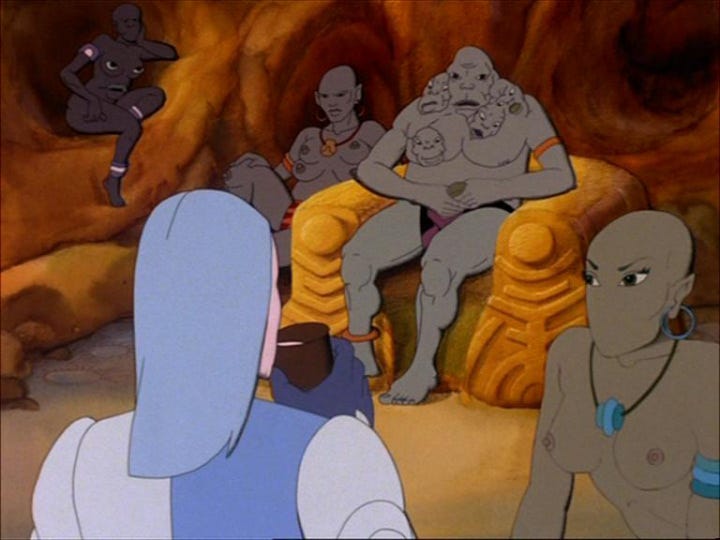


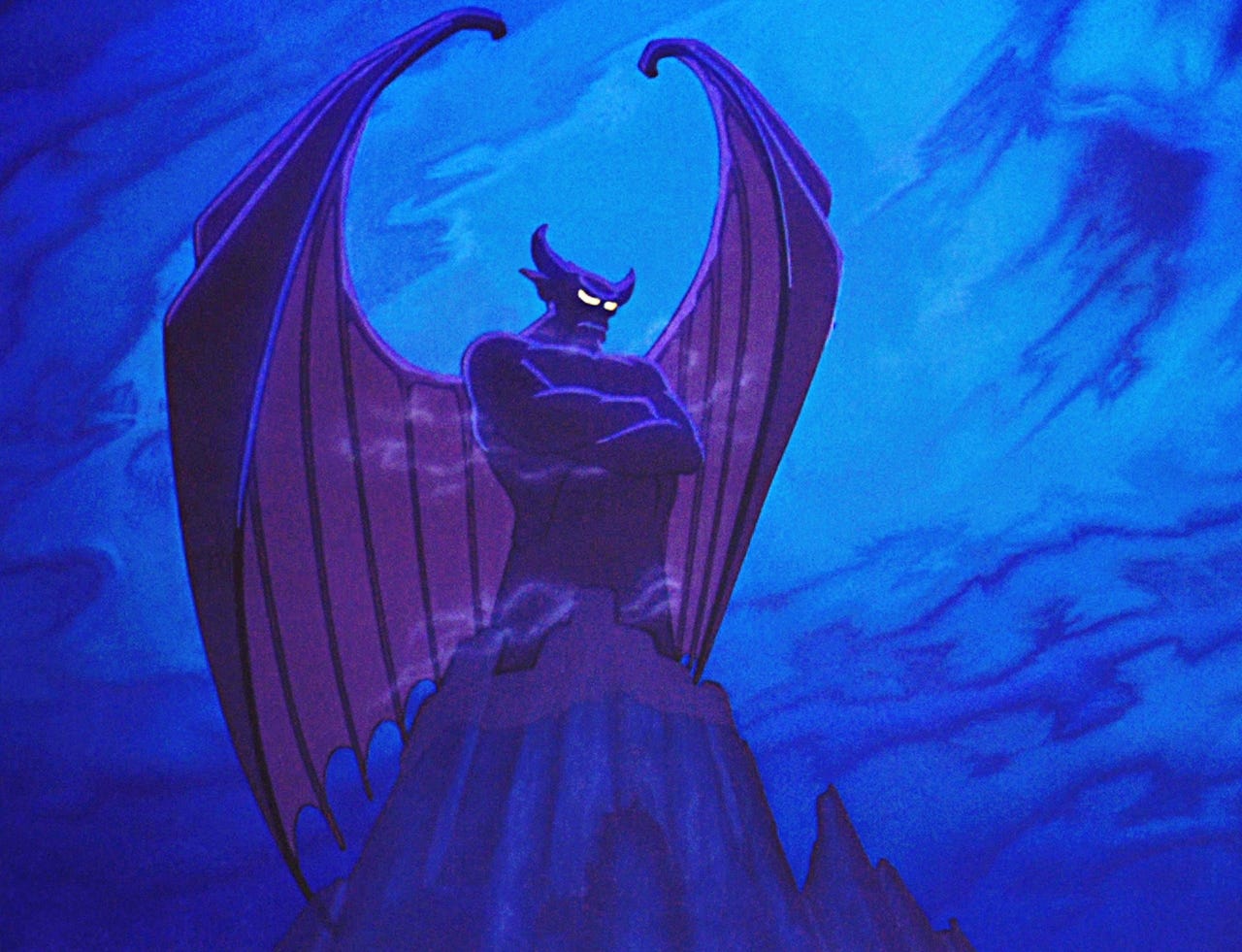
Thanks for this, Joel, on a number of levels. Of course I appreciate your compliments on Fred and my work in the Ur-Quan Masters, but it’s your thesis about embracing the weird that really gets me excited. I enjoy all kinds of fantasy and science-fiction, but I especially love creative work that makes me go, “Huh?”, while also thinking, “COOL!”, like Erol’s artwork. In part this is because I cherish novelty, but what’s really going on is that I am learning something new about myself. And regarding Jack Vance, I’d be interested to know how his work rocked your creative boat so much.